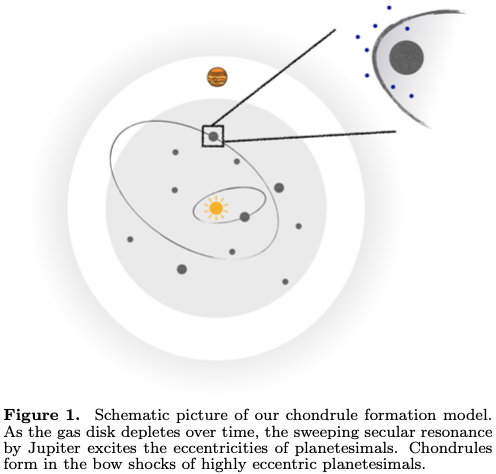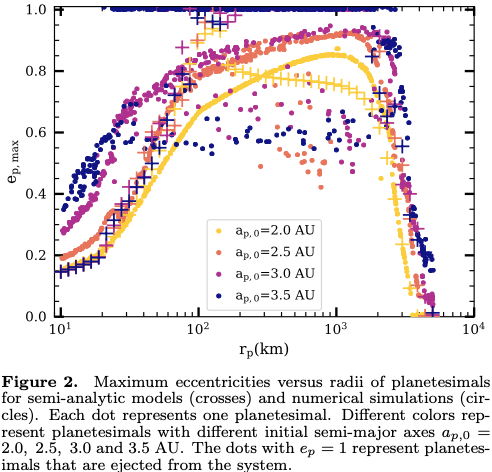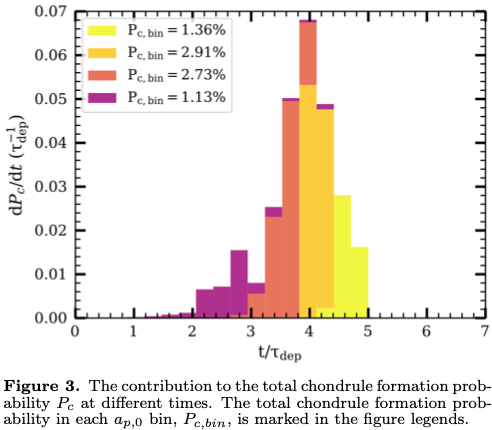Chondrule Formation by the Jovian Sweeping Secular Resonance
- 1Max-Planck Institute for Extraterrestrial Physics, Garching by Munich, 85748, Germany (munan@mpe.mpg.de)
- 2Department of Astronomy and Center for Astrophysics, Tsinghua University, Beijing 10086, China
- 3Institute for Advanced Studies, Tsinghua University, Beijing 10086, China
- 4Department of Astronomy and Astrophysics, University of California Santa Cruz, Santa Cruz, CA 95064, USA
- 5Institut de Recherche en Astrophysique et Planétologie (IRAP) 14 avenue Edouard Belin, 31400 Toulouse, France
Chondritic meteorites, or chondrites, contain some of the oldest and most primitive solids in our solar system. They record the physical conditions at the early phase of the solar nebula evolution and planet formation. Chondrites are mainly composed of chondrules, which are millimeter-sized silicate spheroids. To form the chondrules we see today, chondrule precursors need to be heated to temperatures above 1600 K and cooled down rapidly on timescales of minutes to hours. Considering ordinary chondrites make up about 10% of meteorites found on Earth, chondrule heating events should be common in the early solar system.
One of the most promising mechanisms for chondrule heating is the passage through bow shocks of highly eccentric planetesimals in the protoplanetary disk. This mechanism explains many features in the thermal histories of chondrules, such as the ambient temperature, the peak temperature, and the cooling rate. However, theoretical models so far have difficulties producing a large number of planetesimals with high eccentricities, which is needed to form chondrules efficiently.
In this paper, we investigate a scenario in which the orbits of planetesimals are influenced by both Jupiter and a depleting protoplanetary disk. As the disk mass decreases with time, the location of the Jovian secular resonance moves from the outer to the inner disk. This phenomenon is called the sweeping secular resonance. We propose that this mechanism, illustrated in Figure 1, can explain chondrule formation, by exciting the planetesimals in the asteroid belt region to high eccentricity orbits. We study the orbital evolution of planetesimals in the disk using semi-analytic models and numerical simulations. We investigate the dependence of eccentricity excitation on the planetesimal's size as well as the physical environment, and calculate the probability for chondrule formation.
We find that 50-2000 km planetesimals can obtain eccentricities larger than 0.6, as shown in Figure 2, and lead to effective chondrule heating. Most chondrules form in high-velocity shocks, in low-density gas, and in the inner disk. Figure 3 shows that the age spread of chondrule is comparable to the depletion timescale of the disk, which is directly linked to the timescale for the secular resonance to pass through the asteroid belt region. The fraction of chondrule precursors that become chondrules is about 4-9% between 1.5-3 AU, consistent with observational constraints.
Our model suggests that the depletion timescale for the protoplanetary disk around the Sun is comparable to the age spread of chondrules at around 1 Myr; and that Jupiter formed before chondrules, no more than 0.7 Myr after the formation of the CAIs.
Reference:
Gong M., Zheng X., Lin D.~N.~C., Silsbee K., Baruteau C., Mao S., 2019, ApJ, 883, 164
 .
. 

How to cite: Gong, M., Zheng, X., Lin, D., Silsbee, K., Baruteau, C., and Mao, S.: Chondrule Formation by the Jovian Sweeping Secular Resonance, Europlanet Science Congress 2020, online, 21 September–9 Oct 2020, EPSC2020-395, https://doi.org/10.5194/epsc2020-395, 2020

